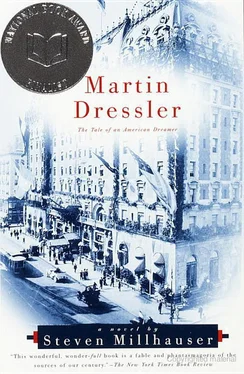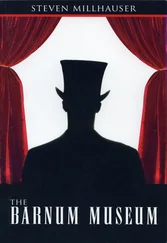It was said that under the thirteenth level a maze of interconnecting passageways had been constructed, each with stairways leading down to still lower levels, unimaginably far down; and there in the world beneath the world, which yet was only the deepest cellar of the cloud-piercing Cosmosarium, black gardens of imagination bloomed. It was said that in the darkness of that sub-subterranean realm, in a forest the color of black tourmaline, wild children, abandoned at birth and speaking no language, were raised by wolves and lived the life of animals. It was said that in moss-stained halls at the ends of crumbling corridors, statues tormented with human longings came to life, roamed the dark with impassioned eyes, and flung themselves upon human lovers, after which they wandered sluggishly until they assumed new and troubling marble poses. There, beneath the world, white and peaceful cities rose in distant river valleys, beckoning the weary of heart and the sick of soul. There, in the Garden of Black Delight, monstrous jet-black blossoms exuded dangerous perfumes, which produced visions of such searing ecstasy that afterward one lost all desire to live. In the House of Metamorphosis, deep in a cave under a hill whose top was an island, Chinese masters trained in secret academies could transform the traveler into a lion, a butterfly, an angel, a waterfall. It was said that to descend into the world beneath the world was to learn the secrets of heaven and hell, to go mad, to speak in tongues, to understand the language of beasts, to rend the veil, to become immortal, to witness the destruction of the universe and the birth of a new order of being; and it was said that if you descended far enough, down past obsidian-black rivers, past caves where dwarves in leather jerkins swung pickaxes against walls veined with gold, down past the lairs of slumbering dragons whose tails were curled around iron treasureboxes, past regions of ice and fire, past legendary underworlds where the shadowy spirits of the dead set sail for islands of bliss and pain, down and down, past legend and dream, through realms of blackness so dark that it stained the soul black, you would come to a sudden, ravishing brightness.
But whether the writers spoke of the imaginary world beneath the building, or of the many worlds within, they all acknowledged, even in their puzzlement, a sense not simply of abundance or immensity, but of the inexhaustible. It was as if, despite the finite number of stories (thirty) and underground levels (thirteen, including the basement), the Grand Cosmo produced in the visitor a conviction that it could never be fully explored, that around the next corner or down the next stairway existed something unexpected, exciting, and never seen before.
And Martin was pleased: the Grand Cosmo was making an impression. If the impression was still a little unclear, if people remained a little uncertain what to make of it all, that was only to be expected, for after all the Grand Cosmo was a leap beyond the hotel, a leap that was bound to take some getting used to. The building was attracting attention as a vast curiosity, but once people took up residence they would understand that the living arrangements of the good old family hotel were no longer possible.
Martin himself had moved from his rooms in the New Dressler to a living space on the twenty-ninth floor of the Grand Cosmo, where a series of folding screens decorated with Japanese hermits, arched wooden bridges, and waterfalls led past parlor chairs and a concealed bed to a desk with a view of the river. Beyond the farthest screen was a copse of artificial trees, through which a path led to the elevators.
Martin looked forward to the attack in the Architectural Record , which did not appear for six weeks and then proved even harsher than he had imagined. For the writer, while briskly acknowledging certain minor technological accomplishments, such as the mechanical singing birds in the parks, refused to see in the Grand Cosmo anything but a culmination of deplorable tendencies. The Grand Cosmo, the article argued, represented in an extreme form the age’s love of the grandiose and the eclectic; it brought together so many clashing elements, in so massive a space, as to produce an impression of confusion, of uncertainty. For what, after all, was the Grand Cosmo? Insofar as it pretended to be a place in which people might wish to live, it was uninhabitable. It seemed to combine elements of the hotel, the museum, the department store, the amusement park, and the theater in a colossal enclosure that itself drew on so many styles as to make the worst excesses of late Victorian eclecticism seem a chaste instance of neoclassical restraint. Although the extravagance of the Grand Cosmo, its flamboyance, its sheer hunger for the all-inclusive, might in some sense be deemed praiseworthy as an expression of energy, that extravagance and flamboyance and hunger had been carried to such heights of excess as to turn into the grotesque. What was striking was how the habit of excess, which expressed itself most readily in the form of architectural gigantism, manifested itself in the smallest details, so that the brass doorknobs of the cellar workshops, the numerals in the panels above the elevators, the artificial leaves on the forty-six varieties of artificial tree, were wrought with a Byzantine elaboration. There was thus a paradoxical sense in which the minutiae of the building were expressions of the architect’s obsession with the gigantic, and a corresponding sense in which the sheer immensity of the structure was an expression of a miniaturist’s tendency toward obsessive elaboration. Both senses betrayed a yearning for the exhaustive, which was the secret malady of the age. In this way the Grand Cosmo might be understood as the ultimate architectural expression of its time, after which a rigorous simplification was inevitable. The article ended with a plea for a return to moderation, reason, and simplicity in the architecture of public buildings.
Martin read the article with close interest, for it seemed to him that the writer, without a shred of sympathy, had penetrated deeply into the nature of the Grand Cosmo. He wondered whether the addition of sympathy would have permitted a still deeper penetration, or whether sympathy would have prevented understanding by getting in the way. It was just the sort of thing he would have liked to discuss with Emmeline, but he could no longer speak to Emmeline in the old way. She was closed to him, she was blind and deaf and dead. And in one sense that was quite right and proper, for during the course of his marriage she had gradually replaced her sister, and now she must efface herself in order that Caroline might regain her rightful place in the scheme of things. But in another sense it was cruel and wrong, for Caroline could not rise above something cramped in her nature, so that by self-effacement Emmeline was sacrificing a rich form of life to an impoverished one. And therefore the fault must surely be his, for marrying the wrong sister. But at the thought of marrying the right sister an irritation came over him, for he felt repelled by the thick eyebrows, the broad back, the strong hands with their blunt fingernails. For he had been able to desire only the pretty and delicate sister, the sister with the difficult twist in her, the sister lost in dream, who lay motionless beneath him and turned away in silence. And an anger came over Martin, at the mumbo-jumbo of love, the damage of it.
He could discuss the article in the Architectural Record only with Rudolf Arling, who strode up and down among his ornate tables heaped with statuettes and ivory animals, denouncing the writer as a fool. Martin, surprised not by the outburst but by his own severe lack of sympathy for it, defended the writer in silence and understood that Arling sought praise, only praise, and could not tolerate one jot of disapproval. The little ivory animals, the statuettes, the curved legs of the tables, all this had begun to remind him of something, and as Arling paced back and forth, throwing out a hand in angry emphasis, it came to Martin: it was the familiar atmosphere, the secret but unmistakable impression, down to the curving table legs themselves, of Mr. Westerhoven’s office. And so the fiery architect with the glittering gray eyes was an emissary of Alexander Westerhoven’s — he might have known. It would simply be a matter of time before Arling accepted none but the safest commissions. Martin himself had been stung solely by the charge that the Grand Cosmo was uninhabitable; despite a new burst of publicity, only forty-nine percent of the living spaces had been rented.
Читать дальше












